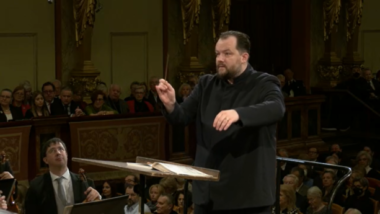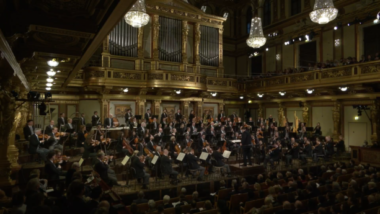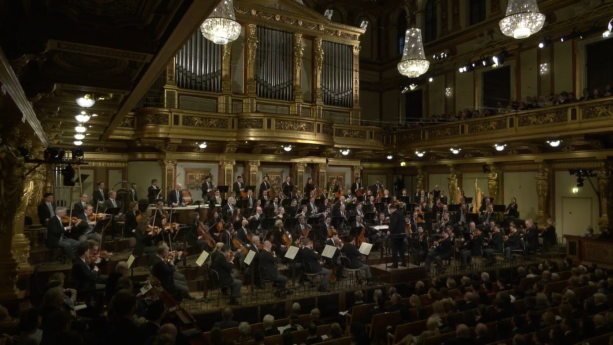 Austria Mahler: Vienna Philharmonic Orchestra / Andris Nelsons (conductor). Livestreamed (directed by Christoph Engel) on STAGE+ from the Musikverein, Golden Hall, Vienna, 15.1.2023. (JPr)
Austria Mahler: Vienna Philharmonic Orchestra / Andris Nelsons (conductor). Livestreamed (directed by Christoph Engel) on STAGE+ from the Musikverein, Golden Hall, Vienna, 15.1.2023. (JPr)

Mahler – Symphony No.7 in E Minor
It is quite a while since I last railed about how you may read – often in BBC Proms programmes – that Mahler’s Seventh Symphony is considered by many to be his ‘most problematic’. I often mention the following that Andrew Huth once wrote: ‘Passing references, perhaps not intentional [my italics], can be heard to music by Schubert, Schumann and Wagner, to Bizet’s Carmen and even Léhar’s The Merry Widow.’ I will repeat what I have written before and that is: ‘One thing most musicologists I would have thought would agree on was that Mahler rarely did anything unintentionally!’
The composer’s duties as conductor at the Vienna Court Opera meant that while he wrote the two middle Nachtmusik – ‘Night music’ or serenade – movements first in the summer of 1904 he then left it for a year uncertain as to what to put around them. There followed the oft-quoted revelatory moment when he stepped into a boat to be rowed over an Alpine lake and got ‘the rhythm and the style of the introduction to the first movement’. So he bookended the two serenades with an Adagio and a Rondo-Finale putting an eerie Scherzo in between them.
The musical world has always been keen to supress for a very long time how in thrall Mahler was to Wagner. Mahler would know how in Mein Leben Wagner claims a precompositional ‘vision’ for the opening to Das Rheingold, this was in in Italy’s La Spezia where there were also boats and water. In the last years of his life (which this sadly was) there is also evidence that Mahler was very anxious about seeming to be the elderly Hans Sachs (from Wagner’s Die Meistersinger) to Alma’s youthful Eva and there is much that frivolously alludes to Alma in the Seventh. The use of the mandolin and guitar in the serenades ironically mimics the unsuccessful wooing of Eva by Beckmesser playing his lute. The Mahler expert, Professor Steven Bruns has written: ‘The interval of the perfect fourth has special significance throughout Wagner’s opera, and the fourth is motivic in Mahler’s Seventh as well. Finally, Mahler was surely referring to the sunny C major of Wagner’s Die Meistersinger in his strategic use of that tonality in the Seventh, especially during the closing measures.’ And with a few conceptual leaps, it has led me to claim for very many years that the Seventh is Mahler’s unacknowledged ‘Wagner Symphony’ and not ‘problematic’ at all! (Don’t of course forget the music in the first movement that was appropriated for the legendary Star Trek theme, but this is another story and it all helps in making this an absolutely fascinating symphony and probably my favourite Mahler one!)

This Mahler concert was the third of four in Vienna and prior to visits to Budapest, Hamburg and Cologne where they played the Seventh each time. Franz Welser-Möst confidently conducted the Vienna Philharmonic in a number of unfamiliar works during an uplifting New Year’s Day Concert in the same Golden Hall a couple of weeks earlier with barely a glance at the scores in front of him, so I was surprised how closely Andris Nelsons needed to follow Mahler’s music. Of course, it was the result they achieved together that is all that mattered and for a symphony with supposedly so many rough edges, Nelsons showed that the Seventh can be approached with a pastorale lyricism. Also, if it is supposed to veer from darkness to light then the darkness that Nelsons allowed to intrude was never more than a dusky hue because wit and an unforced optimism shone through the whole work right to the end of the Rondo-Finale. As you would expect from the players of the Vienna Philharmonic filling the restricted platform of the Golden Hall, the orchestral sound was brilliant, so kaleidoscopic and arresting, and it all added up to a gripping experience.
The dramatically intense first movement was suitably robust and rhapsodic and the steady rhythm of the oars at the start was underscored by eloquent horn playing (here and throughout the symphony) from Josef Reif and Nelsons opting for a mellow, nostalgic-sounding Wagner tuba. Nelson established a positive forward momentum throughout, and a lilting tempo was also a feature of the second movement, the first ‘night music’ marked ‘Allegro moderato’. Basically, it is another march (because this should be apparent too in the first movement), and this one swayed dreamily and there was little nocturnal mystery. To get to the second serenade we had to go through the graveyard of the Scherzo that Mahler marks ‘Shadowy’. It is a brilliant waltz macabre, and its ‘bump in the night’ ghostliness here reminded me more of the antics of the mischievous goblin (Kobold) in Wagner’s Die Meistersinger. Excellent playing from the concertmaster and first viola (Christian Frohn). The gentle Andante amoroso (Nachtmusik II) that followed was a further joy. As heard through loudspeakers the balance Nelsons mostly achieved in the symphony’s quieter moments sounded almost ideal, but the mandolin and guitar were now rather inaudible – played from the rear of the orchestra – and they struggled to make an impact in this fourth movement. We are in the world of the Wunderhorn symphonies once more complete with fleeting birdcalls and these are particularly noticeable after the movement has hastened towards its end. All the musicians played beautifully here, the woodwind especially, due to the conductor’s expressive control.
The second Serenade was every bit a quiet interlude before an exuberant Rondo-Finale where under Nelsons joy seemed unconfined. Shostakovian, before Shostakovich, it argued back and forth in its Rondo-form between serious declamatory moments (loud timpani and triumphant brass) and more inconsequential trills and slides in woodwind and strings. Others may hear their own musical references during the set of variations but with the reappearances of the principal theme from the first movement along with cowbells and other low bells, for me, it is the triumphant strains of the Die Meistersinger Overture which allows Mahler to end the symphony in a blaze of (unusual) cheerfulness and optimism. Nelsons and his incomparable orchestra had brought total coherence to a work where some posit there is none.
Jim Pritchard
